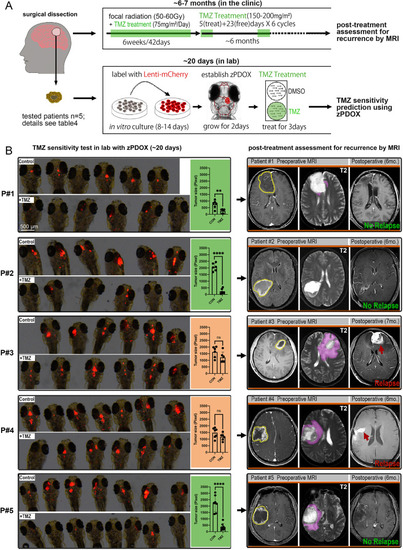
Short-term TMZ response in zebrafish patient-derived orthotopic xenografts (zPDOXs) predicts the tumor relapse in GBM patients treated with TMZ. (A) Schematic showing the procedure of clinical treatment of individual GBM patients and the parallel zPDOX operation in the laboratory. Right, top: after surgical dissection of the primary GBM tissue, the patient was subjected to standard radiotherapy and TMZ chemotherapy. Right, bottom: dissected GBM tissue was sent to the laboratory for establishment of the zPDOX and TMZ sensitivity test. (B) Comparison of short-term TMZ response in zPDOX in terms of tumor size inhibition ratio and the effect of TMZ on the corresponding patient in terms of tumor relapse (6-7 months later). Zebrafish recipients with zPDOX were imaged by a fluorescence stereomicroscope, and each xenograft was then scanned by a confocal microscope and measured by ImageJ. Graphs show the inhibition ratio of xenografts in terms of tumor size after 3 days' TMZ treatment. ns, not significant; **P<0.01, ****P<0.0001 (unpaired two-tailed Student's t-test). All five GBM patients were examined before surgery (Preoperative MRI) and ∼6-7 months after surgery (Postoperative) by MRI. Dotted line circles, gadolinium-enhanced tumor; pink labeling/arrows, vasogenic edema. Red arrows indicate tumor relapse. Scale bars: 500 µm.
|